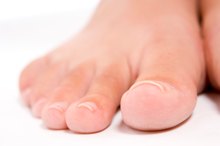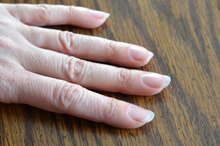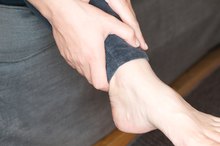How to Care for a Broken Toenail
Toenails consist of a hard material called keratin, which helps to protect the soft tissue at the end of your toes from damage. However, if you strike your toenail hard enough, such as by hitting it against an object or by dropping a heavy weight onto your foot, the nail may break. In some cases, this requires medical attention, but sometimes the damage is merely cosmetic.
Evaluation
The first step in treating a broken toenail is to examine the injury and determine the extent of the damage; if the injury is severe, you may require medical assistance. Check for signs of bleeding and use a sterile bandage or clean cloth to apply pressure to the wound; if the bleeding persists after 10 minutes of pressure, or if there is blood trapped underneath part of the nail that causes intense pain, you should call your doctor immediately. Certain complications may also require a trip to the doctor, regardless of the amount of bleeding involved. If there is dirt trapped underneath the torn edge of the nail that you are unable to clean out on your own, you will need a medical professional to remove it in order to minimize the risk of infection. Diabetics should also schedule an doctor's appointment after receiving a foot injury, due to the added susceptibility to infection.
- The first step in treating a broken toenail is to examine the injury and determine the extent of the damage; if the injury is severe, you may require medical assistance.
- Check for signs of bleeding and use a sterile bandage or clean cloth to apply pressure to the wound; if the bleeding persists after 10 minutes of pressure, or if there is blood trapped underneath part of the nail that causes intense pain, you should call your doctor immediately.
First Aid
What to Do for a Ripped-Loose Fingernail?
Learn More
Assuming the injury does not appear to be severe, the next step is to minimize your discomfort. Unless your doctor has advised you otherwise, take a dose of acetaminophen or ibuprofen every six hours to help relieve the pain. If the nail is torn, use a small pair of scissors to clip away the hanging section of nail. Apply a small amount of antibiotic gel to the injured toenail, then cover the wound with an adhesive bandage. After a week, the nail bed should be healed enough that you will no longer experience any major pain or discomfort. However, it can take two to three months before the nail will grow enough to cover the bed completely.
- Assuming the injury does not appear to be severe, the next step is to minimize your discomfort.
- After a week, the nail bed should be healed enough that you will no longer experience any major pain or discomfort.
Cosmetic Repair
In cases where the break is relatively minor and your primary concern is the nail's appearance, rather than any discomfort, you can purchase a nail-repair kit to help patch the damage 2. These products feature special acrylics designed to form a protective coating over the nail, which you can then sand down and paint as you normally would. Once your nail has grown long enough that you no longer require the acrylic coating, you can remove the product by soaking it in nail polish remover.
Related Articles
References
Writer Bio
Daniel Barrows has been working as a freelance writer for businesses in the Southern California area for over two years. He has also published articles online for websites like eHow.com and Answerbag.com. He has received a Bachelors of Arts in English from the University of California, Berkeley.








